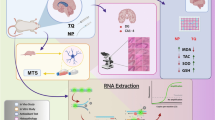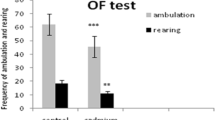Abstract
Triazophos, O,O-diethyl-1-H-1,2,4-triazol-3-yl phosphorothioate, (TZ) is an organophosphate pesticide widely used as an insecticide in agriculture fields, however, its adverse effects on cognitive function remain unknown till date. The present study was designed to identify the effect of TZ on cognitive function in order to gain an insight into the molecular mechanism(s) probably involved in TZ induced toxicity. Wistar male albino rats were orally administered with TZ at 8.2 mg/kg bw daily for 30 days. Cognitive function was assessed by evaluating step down latency (SDL) in passive avoidance apparatus, transfer latency (TL) on elevated plus maze and escape latency (EL) using morris water maze. The biochemical changes, in terms of malondialdehyde (MDA), reduced glutathione (GSH) and brain derived neurotrophic factor (BDNF) levels were evaluated in hippocampi regions. Relative mRNA expression and protein expression of BDNF were also evaluated. The results demonstrated that rats treated with TZ showed significantly (p < 0.01) reduced SDL and prolonged TL and EL as compared to control group rats. Moreover, significantly low (p < 0.01) mRNA expression and protein levels (p < 0.001) of BDNF, increased MDA and reduced GSH levels were observed in TZ treated rats. The study concludes that chronic exposure to TZ significantly impairs the learning and memory which may be attributed to the significantly reduced mRNA and protein expression of BDNF in hippocampus. Moreover, BDNF is negatively correlated to MDA levels and positively correlated to GSH levels. Hence, it can be suggested that interplay between BDNF and oxidative stress plays an important role in mediating the toxic effects of TZ.








Similar content being viewed by others
Abbreviations
- TZ:
-
Triazophos
- BDNF:
-
Brain derived neurotrophic factor
- GSH:
-
Reduced glutathione
- MDA:
-
Malondialdehyde
- SDL:
-
Step down latency
- TL:
-
Transfer latency
- EL:
-
Escape latency
- MWM:
-
Morris water maze
References
Alonso M, Bekinschtein P, Cammarota M, Vianna MRM, Izquierdo I, Medina JH (2005) Endogenous BDNF is required for long-term memory formation in the rat parietal cortex. Learn Mem 12:504–510
Amoureux S, Sicard P, Korandji C, Borey A, Benkhadra S, Le Grand AS, Vergely C, Girard C, Rochette L (2008) Increase in levels of BDNF is associated with inflammation and oxidative stress during cardiopulmonary bypass. Int J Biomed Sci 4:204–211
Bekinschtein P, Cammarota M, Igaz LM, Bevilaqua LR, Izquierdo I, Medina JH (2007) Persistence of long-term memory storage requires a late protein synthesis- and BDNF dependent phase in the hippocampus. Neuron 53:261–277
Bekinschtein P, Cammarota M, Katche C, Slipczuk L, Rossato JI, Goldin A, Izquierdo I, Medina JH (2008) BDNF is essential to promote persistence of long-term memory storage. PNAS 105:2711–2716
Boutahar N, Reynaud E, Lassabliere F, Brog J (2010) Brain derived neurotrophic factor inhibits cell cycle re-entry but not endoplasmic reticulum stress in cultured neurons following oxidative or excitotoxic stress. J Neurosci Res 88:2263–2271
Bradford MM (1976) A dye binding assay for protein. Anal Biochem 72:248–254
Bushnell PJ, Kelly KL, Ward TR (1994) Repeated inhibition of cholinesterase by chlorpyrifos in rats: behavioral neurochemical, and pharmacological indices of tolerance. J Pharmacol Exp Ther 270:15–25
Bushnell PJ, Moser VC, Samsam TE (2001) Comparing cognitive, and screening test for neurotoxicity effects of acute chlorpyrifos on visual signal detection, and a neurobehavioral test battery in rats. Neurotoxicol Teratol 23:33–44
Bushnell PJ, Padilla SS, Ward T, Pope CN, Olszyk VB (1991) Behavioral and neurochemical changes in rats dosed repeatedly with diisopropylfluorophos-phate. J Pharmacol Exp Ther 256:741–750
Chomczynski P, Sacchi N (1987) Single-step method of RNA isolation by acid guanidinium thiocyanate-phenol-chloroform extraction. Anal Biochem 162:152–159
Donovan MJ, Lin MI, Wiegn P, Ringstedt T, Kraemer R et al (2000) Brain derived neurotrophic factor is an endothelial cell survival factor required for intramyocardial vessel stabilization. Development 127:4531–4540
Ellman GL (1959) Tissue sulphydryl groups. Arch Biochem Biophy 82:70–77
Ernfors P, Lee KF, Jaenisch R (1994) Mice lacking brain-derived neurotrophic factor develop with sensory deficits. Nature 368:147–150
Hofer M, Pagliusi SR, Hohn A, Leibrock J, Barde Y-A (1990) Regional distribution of brain-derived neurotrophic factor mRNA in the adult mouse brain. EMBO J 9:2459–2464
Itoh J, Nabeshima T, Kameyama T (1990) Utility of an elevated plus-maze for the evaluation of memory in mice: effect of nootropics, scopolamine and electroconvulsive shock. Psychopharmacology 101:27–33
Izquierdo I, Fin C, Schmitz PK, Da Silva RC, Jerusalinsky D, Quillfeldt JA, Ferreira MB, Medina JH, Bazan NG (1995) Memory enhancement by intrahippocampal, intraamygdala, orintraentorhinal infusion of platelet-activating factor measured in an inhibitory avoidance task. Proc Natl Acad Sci USA 92:5047–5051
Jain S, Ahmed RS, Arora VK, Banerjee BD (2011) Biochemical and histopathological studies to assess chronic toxicity of Triazophos in blood, liver and brain tissue of rats. Pestic Biochem Phys 100:182–186
Jain S, Subramaneyaan M, Ahmed RS, Arora VK, Banerjee BD (2010) Induction of oxidative stress and histopathological changes by sub-chronic doses of Triazophos. Indian J Biochem Biophys 47:388–392
Kapczinski F, Frey BN, Andreazza AC, Kauer-Sant’Anna M, Cunha AB, Post RM (2008) Increased oxidative stress as a mechanism for decreased BDNF levels in acute manic episodes. Rev Bras Psiquiatr 30:243–245
Kumar M, Kumar A (2007) Report on application and health effects of pesticides commonly used in India. Centre for Science and Environment, New Delhi
Lee B, Cao R, Choi YS, Cho HY, Rhee AD, Hah CK, Hoyt KR, Obrietan K (2009) The CREB/CRE transcriptional pathway: protection against oxidative stress-mediated neuronal cell death. J Neurochem 108:1251–1265
Linnarsson S, Bjorklund A, Ernfors P (1997) Learning deficit in BDNF mutant mice. Eur J Neurosci 9:2581–2587
Livak KJ, Schimittgen TD (2001) Analysis of relative gene expression data using real-time quantitative PCR and the 2−ΔΔCT method. Methods 25:402–408
López-Granero C, Cañadas F, Cardona D, Yu Y, Giménez E, Lozano R, Avila DS, Aschner M, Sánchez-Santed F (2013) Chlorpyrifos-, diisopropylphosphorofluoridate-, and parathion-induced behavioral and oxidative stress effects: are they mediated by analogous mechanisms of action? Toxicol Sci 131:206–216
Lyons WE, Mamounas LA, Ricaurte GA, Coppola V, Reid SW, Bora SH, Wihler C, Koliatsos VE, Tessarollo L (1999) Brain-derived neurotrophic factor-deficient mice develop aggressiveness and hyperphagia in conjunction with brain serotonergic abnormalities. Proc Natl Acad Sci USA 96:15239–15244
Mandodari C, Hehgerer B, Ducret T, Borkowoski J (1994) Delayed emergence of effects of memory enhancing drugs: implications for the dynamics of long term memory. Proct Natl Acad Sci 91:2041–2045
Morris R (1984) Developments of a water-maze procedure for studying spatial learning in the rat. J Neurosci Meth 11:47–60
Musazzi L, Cattaneo A, Tardito D, Barbon A, Gennarelli M, Barlati S, Racagni G, Popoli M (2009) Early raise in BDNF in hippocampus suggests induction of posttranscriptional mechanisms by antidepressants. BMC Neurosci 10:48. doi:10.1186/1471-2202-10-48
Narayanan SN, Kumar RS, Potu BK, Nayak S, Mailankot M (2009) Spatial memory performance of Wistar rats exposed to mobile phones. Clinics 64:231–234
Numakawa T, Matsumoto T, Numakawa Y, Richards M, Yamawaki S, Kunugi H (2011) Protective action of neurotrophic factors and estrogen against oxidative stress-mediated neurodegeneration. J Toxicol 2011:405194. doi:10.1155/2011/405194
OECD (2007) Organization for Economic Co-operation and Development (OECD) guidelines for the testing of chemicals 407: repeated dose 28-day oral toxicity study in rodents
Ohkawa H, Ohishi N, Yagi K (1979) Assay for lipid peroxides in animal tissues by thiobarbituric acid reaction. Anal Biochem 95:351–358
Patterson SL, Abel T, Deuel TAS, Martin KC, Rose JC, Kandel ER (1996) Recombinant BDNF rescues deficits in basal synaptic transmission and hippocampal LTP in BDNF knockout mice. Neuron 16:1137–1145
Rani S, Madan VK, Kathpal TS (2001) Persistence and dissipation behavior of triazophos in canal water under Indian climatic conditions. Ecotoxicol Environ Safety 50:82–84
Salehi I, Farajnia S, Mohammadi M, Ghannad MS (2010) The pattern of brain-derived neurotrophic factor gene expression in the hippocampus of diabetic rats. Iran J Basic Med Sci 13:146–153
Singh M, Rishi S (2005) Plasma acetylcholinesterase as a biomarker of Triazophos neurotoxicity in young and adult rats. Environ Toxicol Pharmacol 19:471–476
Pierre J, Drori S, Uldry M, Silvaggi JM, Rhee J, Jäger S, Handschin C, Zheng K, Lin J, Yang W, Simon DK, Bachoo R, Spiegelman BM (2006) Suppression of reactive oxygen species and neurodegeneration by the PGC-1 transcriptional coactivators. Cell 127:397–408
Wang X, Bu HF, De Plaen IG, Tan XD (2009) Milk fat globule-EGF factor 8 mRNA expression in rat splanchnic tissues during postnatal development. Int J Clin Exp Med 2:36–40
Wu A, Ying Z, Gomez-Pinilla F (2004) The interplay between oxidative stress and brain-derived neurotrophic factor modulates the outcome of a saturated fat diet on synaptic plasticity and cognition. Eur J Neurosci 19:1699–1707
Yamamoto H, Gurney ME (1990) Human platelets contain brain derived neurotrophic factor. J Neurosci 10:3469–3478
Zou J, Crews F (2006) CREB and NF-kappa B transcription factors regulate sensitivity to excitotoxic and oxidative stress induced neuronal cell death. Cell Mol Neurobiol 26:385–405
Acknowledgments
One of the authors ‘Ms Smita Jain’ is grateful to Council of Scientific and Industrial Research (CSIR) for awarding financial support as Senior Research Fellowship. The authors acknowledge Dr. Mohit Mehndiratta, Assistant Professor, Department of Biochemistry, UCMS for providing help and support during utilization of Real Time PCR system.
Conflict of interest
None declared.
Author information
Authors and Affiliations
Corresponding author
Rights and permissions
About this article
Cite this article
Jain, S., Banerjee, B.D., Ahmed, R.S. et al. Possible Role of Oxidative Stress and Brain Derived Neurotrophic Factor in Triazophos Induced Cognitive Impairment in Rats. Neurochem Res 38, 2136–2147 (2013). https://doi.org/10.1007/s11064-013-1122-0
Received:
Revised:
Accepted:
Published:
Issue Date:
DOI: https://doi.org/10.1007/s11064-013-1122-0




